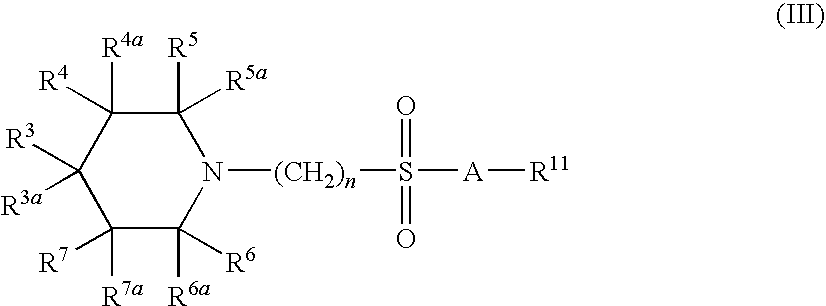Methods and compositions for treating amyloid-related diseases
a technology for amyloid-related diseases and compositions, applied in the direction of drug compositions, peptides, cardiovascular disorders, etc., can solve the problems of amyloid fibrils, once deposited, becoming toxic to the surrounding cells, progressive memory loss, severe pain, etc., to block amyloid-induced neurotoxicity or microglial activation, slow down deposition, and block amyloid-induced cellular toxicity or macrophage activation
- Summary
- Abstract
- Description
- Claims
- Application Information
AI Technical Summary
Benefits of technology
Problems solved by technology
Method used
Image
Examples
examples
Binding and Antifibrillogenic Assays
[0415]The test compounds were synthesized and screened by mass spectrometry (“MS”) assays, except for selected compounds which were purchased from a commercial source. The MS assay gives data on the ability of compounds to bind to proteins, in this example, to β-amyloid and IAPP.
[0416]In the MS assay for Aβ40, samples were prepared as aqueous solutions (adding 20% ethanol if necessary to solubilize in water), 200 μM of a test compound and 20 μM of solubilized Aβ40, or 400 μM of a test compound and 40 μM of solubilized Aβ40. The pH value of each sample was adjusted to 7.4 (±0.2) by addition of 0.1% aqueous sodium hydroxide. The solutions were then analyzed by electrospray ionization mass spectrometry using a Waters ZQ 4000 mass spectrometer. Samples were introduced by direct infusion at a flow-rate of 25 μL / min within 2 hr. after sample preparation. The source temperature was kept at 70° C. and the cone voltage was 20 V for all the analysis. Data w...
PUM
| Property | Measurement | Unit |
|---|---|---|
| concentration | aaaaa | aaaaa |
| pH | aaaaa | aaaaa |
| particle size | aaaaa | aaaaa |
Abstract
Description
Claims
Application Information
 Login to View More
Login to View More - R&D
- Intellectual Property
- Life Sciences
- Materials
- Tech Scout
- Unparalleled Data Quality
- Higher Quality Content
- 60% Fewer Hallucinations
Browse by: Latest US Patents, China's latest patents, Technical Efficacy Thesaurus, Application Domain, Technology Topic, Popular Technical Reports.
© 2025 PatSnap. All rights reserved.Legal|Privacy policy|Modern Slavery Act Transparency Statement|Sitemap|About US| Contact US: help@patsnap.com



